[Interview] The FIR promotes the values at the heart of CA Normandie Seine
Interview with Nicolas Denis, Managing Director, CA Normandie-Seine
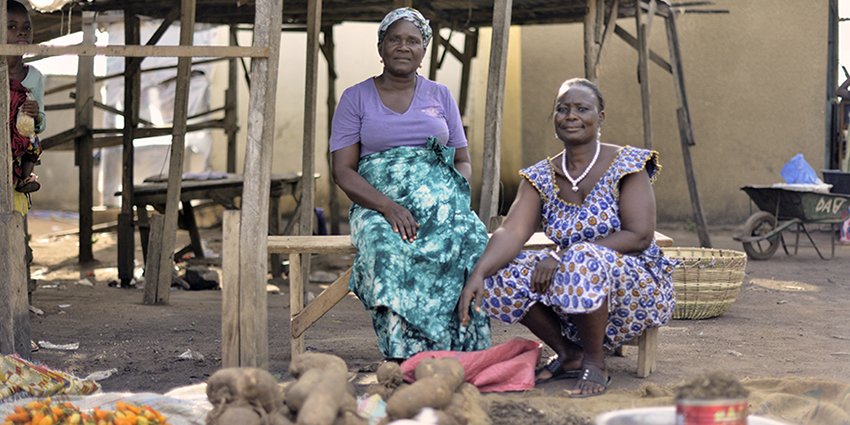
© Didier Gentilhomme
Launched by the Grameen Crédit Agricole Foundation, the Inclusive Finance in Rural Areas (FIR) fund allows Crédit Agricole Group entities to invest in microfinance and social entrepreneurship in emerging countries. Contributing €500,000 to the fund, the Normandie-Seine Regional Bank sees it as a responsible approach in line with the actions it carries out in its region.
– What objectives does your Fund pursue by investing in the FIR fund?
Nicolas Denis, Managing Director of Crédit Agricole Normandie-Seine : The values of social responsibility are at the heart of our Regional Bank's corporate vision; they are in our DNA. It is natural for us to partner with the FIR fund supported by the Grameen Crédit Agricole Foundation because it promotes these same values. The impact is to combat poverty by providing access to financial services to rural communities in developing countries. This is in line with the actions that the Regional Bank is already carrying out, for example by supporting and financing responsible companies such as the producer of ecological oils Olvea, the manufacturer of sustainable acacia gums Nexira, and the Nutriceps program fighting malnutrition in rural areas.
– What is your view on these new social impact investments?
As a regional bank, our economic activity plays a key role in the social life of the regions. We play a supportive and accompaniment role in numerous initiatives whose effects are beneficial at the local level. Microfinance and social and responsible entrepreneurship are realities whose development we support. Our bank supports ADIE, a specialist in entrepreneurial microcredit, the Réseau Entreprendre, as well as local initiative platforms for unsecured loans. We also participate in crowdfunding platforms such as Tubigo, Babyloan, and Miimosa. We are also present alongside AFDI in Normandy, an organization that builds links between French agricultural professionals and projects in Cambodia and Mali, in particular.
– Do these models represent hope, a future?
Personally, I'm struck by how abundant and promising these new models are. When put into practice, crowdfunding and microcredit prove to be much more than new financing avenues. They are also excellent vehicles for information and societal integration of projects that accelerate the connection between an offer and the public. In addition to the FIR fund, this year we are supporting the Femmes & Challenges fund, intended for women entrepreneurs working to promote gender equality. We see it every day: in direct contact with the real economy and society, these approaches are formidable tools for social transformation.
Source : 2019 Integrated Report, Grameen Crédit Agricole Foundation. Download here
New signatories to protect microfinance from the economic effects of Covid-19

In response to the health and economic crisis caused by Covid-19, a group of donors, platforms, and key stakeholders in the inclusive microfinance sector have established a joint commitment: "Key Principles to Protect Microfinance Institutions and Their Clients in the Covid-19 Crisis." At the initiative of the Grameen Crédit Agricole Foundation, this commitment was developed in consensus with all the initial signatories. The objective is to protect both microfinance institutions and their clients to ensure continued access to financing under the best possible conditions and to ensure the well-being of clients and staff.
The commitment aims to guide stakeholders in better supporting microfinance institutions and vulnerable clients during this crisis. The core principles of this commitment are the sharing of available information, analyses, and anticipations, as well as the concerted implementation of shared decisions. The signatories agree to coordinate policies, technical assistance, and resources to help microfinance institutions cope with this unprecedented crisis.
Since its publication in May, six new organizations have signed the pledge. This initiative now has 26 active signatories in Africa, Asia, Eastern Europe, and Latin America: ADA, Alterfin, Azerbaijan Microfinance Association, Bamboo Capital Partners, CERISE, CIDR Pamiga, Cordaid Investment Management, Crédit Agricole CIB India, Crédit Agricole Indosuez Wealth (Asset Management), Crédit Agricole SA, European Microfinance Network, Grameen Crédit Agricole Foundation, FS Impact Finance, GAWA Capital, InFiNe.lu, Inpulse, Kiva, Luxembourg Microfinance And Development Fund, MCE Social Capital, Microfinance African Institutions Network, Microfinance Center, Rabo Foundation, SIDI, SIMA, Social Performance Task Force, and Whole Planet Foundation.
The signatories invite other stakeholders to join this joint initiative. Coordinating efforts to support the actions of microfinance institutions is essential to overcome this crisis.
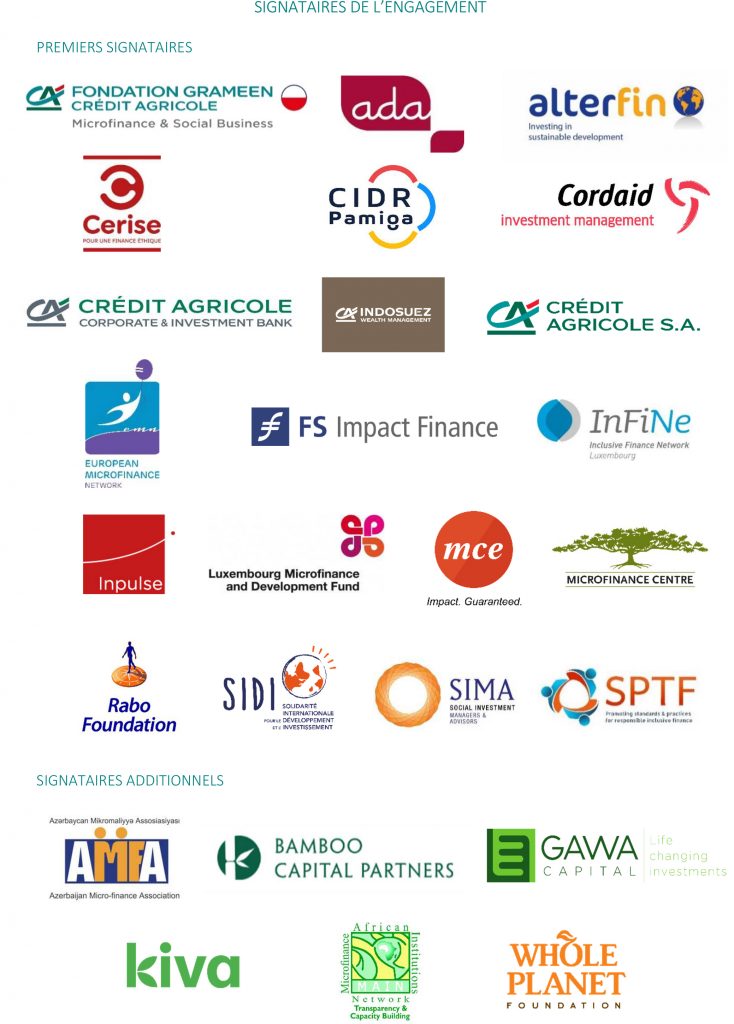
Responsible approaches of institutions to the effects of Covid-19
By Grameen Crédit Agricole Foundation
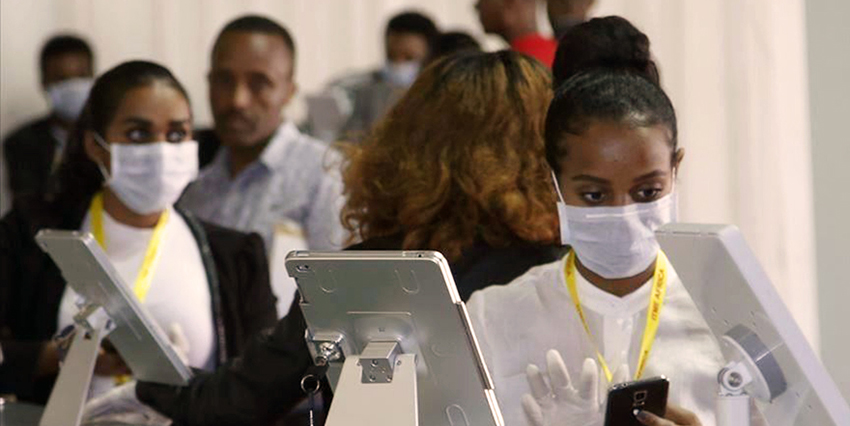
Last April, the Africa's Pulse study, a journal of the World Bank Group, estimated that economic growth in sub-Saharan Africa would fall from +2.4% to a range of between -2.1% and -5.1%, which would constitute the first recession in the region in 25 years. This recession is expected to hit countries dependent on mining and oil exports, while countries without natural resources are expected to show slower but positive growth.
The Grameen Crédit Agricole Foundation, in constant contact with its network of 80 partner microfinance institutions (MFIs) and social enterprises in 40 countries, continues its work of collecting information, analyzing, and sharing its observations. The privileged testimonies of our partners allow us to continue monitoring the crisis and its consequences. In this latest questionnaire, we focused on two specific aspects: the operational adaptations of MFIs and the role of loan officers during this crisis.
In summary
The economic crisis has become a reality for the vast majority of microfinance institutions supported by the Grameen Crédit Agricole Foundation. Almost all of them have implemented massive loan deferral programs to facilitate their borrowers' economic recovery.
The loan officers at these institutions are the primary point of contact between clients and microfinance institutions. They spend nearly half of their working hours reviewing and implementing loan deferral requests.
Institutions quickly adopted programs to reduce their burdens, ensuring the social protection of their employees and safeguarding jobs. Only 12% of them carried out redundancies, which is relatively low compared to national averages. However, institutions are postponing their recruitment programs and a large portion of their investments. They also appear to be seeking to direct their funding toward sectors currently considered less risky. This is particularly the case with agriculture. This observation is recent. It remains to be confirmed and will be closely monitored in our upcoming news updates.
By proactively seeking ways to counter the crisis and ensuring responsible approaches, MFIs are on the right track: today's innovative solutions could also be their successes tomorrow.
Institutions are now focusing on risk treatment
While the health crisis appears to be stalling in countries that have adopted the most effective measures, lockdown exit plans suggest a very gradual recovery in economic activity. Our latest results confirm what we have been observing for several weeks: the remarkable adaptability of microfinance institutions in the face of an unprecedented crisis.
Nearly 90% institutions have established a crisis committee, chaired by the Director General and including the Executive Committee, to oversee various decisions and address the effects of the crisis. This committee generally meets weekly.
“We have created a ‘crisis management team’ composed of members of the executive committee and supported by the chairman of the board whenever necessary. We have a weekly meeting with the board of directors to take stock of the situation and validate key decisions.” – Partner in Myanmar
The effects of the crisis are now being felt by 81% of the partners surveyed, who report an increase in risks to their client portfolio. Responding to this risk is now focusing the bulk of microfinance institutions' efforts, to the detriment of other activities now considered less essential (nearly one in two of them provided this type of service at the beginning of April, compared to one in three today). This reduction in activity aimed at providing non-financial services (awareness campaigns, information campaigns, equipment supply, etc.) is allowing for strong growth in activities dedicated to credit restructuring.
“To support our customers over the coming months, we are proposing the suspension of principal and interest payments to all customers who were not in the at-risk portfolio as of March 1. To date, 75% of the customers contacted have accepted. The process will continue.” – Partner in Ivory Coast
Institutions are adapting financially and operationally
The table below shows the progression of the difficulties encountered and the mitigation measures implemented to address them.
On the financial level
Currency volatility in this context is weighing on institutions' treasuries: 64% of respondents outside the CFA Franc zone are facing a sharp devaluation of their local currency against the dollar. This devaluation directly impacts institutions that have borrowed in this currency, since they themselves receive the vast majority of microcredit interest in local currency.
“The situation is further aggravated by the significant devaluation of the KGS in recent months, which contributes to increasing the cost of currency hedging” – Partner in Kyrgyzstan
The information provided by our partners in this survey also confirms the quasi-mandatory measures taken by MFIs during the crisis: 67% of the MFIs surveyed reduced or stopped microcredit disbursements. A similar proportion of institutions began massively restructuring loans to small borrowers by granting payment deferrals of 3 months, on average. These moratorium periods constitute a truly essential element of crisis management, at all levels. Whether mandated by local regulators or spontaneously proposed by MFIs, they allow borrowers to benefit from a reduction in costs before resuming their activities. Similarly, the numerous processes for deferring investor repayments allow MFIs to conserve precious liquidity in a period of uncertainty. The Grameen Crédit Agricole Foundation, for example, granted numerous payment deferrals in April, in close consultation with other lenders.
The crisis, however, has not affected MFIs' proactivity and is encouraging them to adapt. To this end, some are seeking more resilient sectors in this context of economic crisis. Thus, we noted that 40% of institutions are considering moving into the agricultural sector, whereas this sector was rather neglected because it was considered riskier before the crisis. This point will be particularly monitored in future questionnaires, as this percentage seems to us to mark a notable change in attitude. This new direction is being considered by more than half of MFIs whose agricultural loans do not exceed a third of their portfolio, but also by very rural and agricultural MFIs. It is still too early to say, but the current crisis could encourage institutions to discover traditionally neglected sectors.
“We are moving forward with plans on rural and agricultural financing” – Partner in Sierra Leone
In terms of activity
Regarding activity, the difficulties of team travel are tending to ease somewhat: 55% experienced difficulties in May compared to nearly 80% in April. On the other hand, group meetings are still prohibited, and the ban is growing, which penalizes the institutions' relational processes, primarily with clients who have no alternative to solidarity loans.
“Group meetings were held weekly or bi-weekly for reimbursements and social gatherings. Without a group meeting, you can no longer demand reimbursement.” – Partner in Kenya
On the social front, only 12% of respondents have had to lay off employees since the start of the crisis, which is, however, quite low compared to national averages for growth in unemployment figures. Our partners seem to be following the first principle established by SPTF (1) "Keep staff employed" according to which "today's employees will be tomorrow's assets". For a large number of our partners, parting with employees during a critical period seems like a greater loss than a slight cyclical economic gain. On the other hand, expectations are already weighing on our partners' growth and development projects, since nearly one in two institutions has put these current recruitment projects on hold. This uncertainty is also weighing on organizational projects, with 41% of the MFIs surveyed having decided to postpone this type of internal project.
Staff protection remains a key focus, with 90% MFIs continuing to provide significant resources and remind them of barrier gestures. From the start of the crisis, our partners made rapid decisions to reduce their fixed costs and limit the risk of exposure to the health crisis: mandatory paid leave (52%), teleworking (62%), team rotation, reduced working hours (57%), and reduced branch opening hours (52%). The level of progress in internal digitalization at certain institutions has encouraged these organizational changes. This is particularly the case for our partners in Europe and Central Asia, who benefit from numerous electronic and online tools.
“Most of us at headquarters are working remotely, thanks to our own remote IT system that allows all departments to continue working seamlessly” – Partner in Georgia
The current crisis, which, as we have seen, is limiting MFIs' "business as usual" capabilities, has led us to study the adaptation of the loan officer profession, at the heart of the microfinance business. Some missions remain the same, particularly for MFIs in the least affected countries: loan disbursements (43%), repayment monitoring (38%), or client file analysis (43%).
The restructuring of ongoing loans is taking an increasingly important place in the daily lives of credit officers (43%), with the encouragement to use mobile payments (36%) and the drafting of amendments linked to deferred repayments (31%).
Just as in the retail banking sector, where the relationship manager has demonstrated their importance during times of crisis, loan officers in microfinance institutions are the primary contact for clients. 81% of respondents stated that the essential role of loan officers is to maintain contact with clients and/or credit group leaders.
We maintain contact with all individual clients, group leaders, and village bank presidents through digital and telephone channels. – Partner in Zambia
Strengthen interaction with clients via (smart) phone or other digital devices and carry out collections through the group leader if possible – International MFI Network
This essential and massive approach is all the more important since it is recognized by the Social Performance Task Force (SPTF) in its responsible crisis principles, as being essential in times of customer fragility. It should also be noted that 33% of the MFIs have initiated surveys with their clients to better understand their needs and offer suitable offers and services. For almost half of the MFIs (43%) the advisors also have the role of "health advisor" by reminding people of good hygiene measures, this is particularly the case in West Africa and Europe.
“One of the best investments you can make right now is to maintain close contact with your customers. Many can't make payments, but they're still valuable assets.” – SPTF
__________________________________________________
(1) SPTF is a non-profit organization that engages with inclusive finance stakeholders to develop and promote social performance management standards and best practices.
Crédit Agricole and Dai-ichi Life join forces to provide microfinance for women
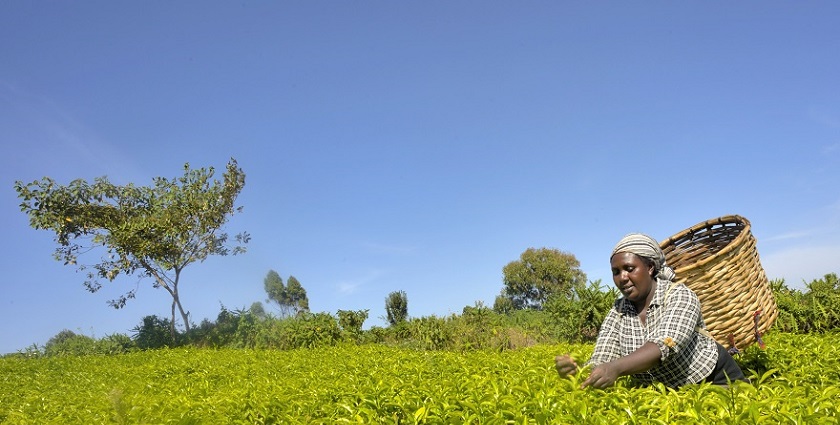
©Philippe Lissac
May 14, 2020. Among the 1.7 billion unbanked adults worldwide, women are overrepresented: approximately 980 million of them do not have a bank account, which corresponds to 56% of the world's unbanked (World Bank). They are therefore part of the target population for microfinance, which provides a range of financial products and services to people excluded from the banking system.
To support the development of microfinance for women, Dai-ichi Life Insurance Company Limited, the Tokyo branch of Crédit Agricole CIB, and the Grameen Crédit Agricole Foundation have implemented an innovative initiative. Dai-ichi Life Insurance Company has invested 2 billion yen in a 10-year loan scheme, structured by Crédit Agricole CIB, to promote microfinance for women. This initiative will enable the Grameen Crédit Agricole Foundation to support microfinance institutions that support women and social enterprises in rural economies in developing countries.
This is the first-ever loan program of its kind implemented by the Crédit Agricole Group. “This exceptional operation perfectly illustrates the Ambitions of the Group Project 2022. It reaffirms our client-centric model and our efforts to offer them innovative solutions in Asia, while reinforcing our commitment to responsible investment,” said Michel Roy, Senior Regional Officer of Crédit Agricole CIB for Asia-Pacific.
With this partnership, Dai-ichi Life Insurance Company strengthens its commitment to impactful investments. “We are honored to financially support the Grameen Crédit Agricole Foundation and its work to promote the financial and entrepreneurial inclusion of women in developing countries. As a responsible institutional investor, Dai-ichi Life will continue to actively engage in ESG investments and contribute to the establishment of a sustainable social framework in the world,” said Tetsuya Kikuta, Director and Executive Officer of the company.
For the Foundation, this is a tremendous opportunity to strengthen its work in developing countries. “Alongside Crédit Agricole CIB and Dai-ichi Life, we will increase our support for women’s empowerment through microfinance and female entrepreneurship. We are very proud to be part of this innovative and unique partnership in the history of the Crédit Agricole Group,” commented Eric Campos, CEO of the Grameen Crédit Agricole Foundation.
PAGE – COVID 19
a:7:{s:8: »location »;a:1:{i:0;a:1:{i:0;a:3:{s:5: »param »;s:13: »page_template »;s:8: »operator »;s:2: »== »;s:5: »value »;s:16: »page-covid19.php »;}}}s:8: »position »;s:6: »normal »;s:5: »style »;s:7: »default »;s:15: »label_placement »;s:3: »top »;s:21: »instruction_placement »;s:5: »label »;s:14: »hide_on_screen »;a:1:{i:0;s:11: »the_content »;}s:11: »description»;s:0: » »;}
An international coalition to protect microfinance institutions and their clients in the Covid-19 crisis
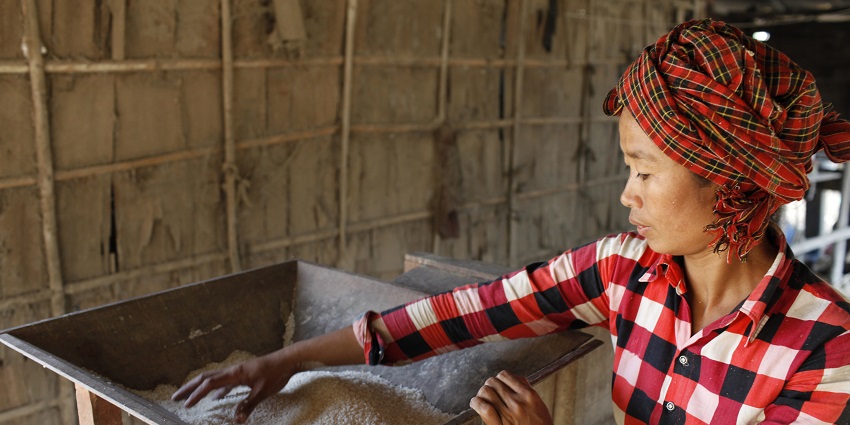
©Philippe Lissac
At the initiative of the Grameen Crédit Agricole Foundation, a group of donors and microfinance platforms has worked on a set of principles to better support the microfinance sector during the health and economic crisis caused by Covid-19. Grameen Crédit Agricole Foundation, ADA, Alterfin, Cherry, CIDR Pamiga, Cordaid Investment Management, Crédit Agricole CIB India, CA Indosuez Wealth (Asset Management), European Microfinance Network, FS Impact Finance, InFiNe.lu, Inpulse, Luxembourg Microfinance And Development Fund, MCE Social Capital, Microfinance Center, Rabo Foundation, SIDI, SIMA And Social Performance Task Force are the first signatories of a joint commitment aimed at supporting microfinance institutions and vulnerable clients during this crisis.
Globally, microfinance institutions provide financial and non-financial products and services to more than 140 million low-income clients [1]. Microfinance plays a vital role in financing income-generating activities in both the formal and informal sectors. In the context of the Covid-19 crisis, microenterprises in the informal economy and small businesses are a key component of economic and social recovery. Supporting microfinance institutions in this context is therefore of paramount importance to protect their most vulnerable borrowers.
Faced with these challenges, a group of donors and microfinance platforms have taken up the challenge and established a common commitment: “ Key principles to protect microfinance institutions and their clients in the Covid-19 crisis ". It aims to guide donors and other stakeholders to better support microfinance institutions and vulnerable clients during this crisis. It draws on best practices and tools from the microfinance sector, such as the work carried out by the Social Performance Task Force [2] and the IAMFI Principles on Debt Rescheduling in Microfinance [3].
The fundamental principles of this commitment are the pooling of available information, analyses, and anticipations, as well as the concerted implementation of shared decisions. The signatories agree to coordinate policies, technical assistance, and resources to help microfinance institutions cope with the crisis. The objective is to protect both microfinance institutions and their clients, ensuring continued access to financing under the best possible conditions and ensuring the well-being of clients and staff.
Because individual obligations and mandates may influence how the commitment's provisions are implemented, this is not a legally binding agreement. It is not a fixed document; it may be improved as needed to better respond to the evolving crisis. Signatories to the commitment will maintain open communication with their peers to share their decisions and adhere to these principles.
The signatories invite other stakeholders to join this joint and committed initiative. The involvement of private, public, and solidarity-based actors is central to monitoring and supporting the actions of microfinance institutions worldwide. Strengthening the impact of financial inclusion is essential to combating poverty in this unprecedented context.
—————————————————-
[1] Microfinance Barometer 2019
[2] https://sptf.info/resources/covid19
[3] Charting the Course: Best Practices and Tools for Voluntary Debt Restructurings in Microfinance, IAMFI, Morgan Stanley, 2011. The document is available on Findev Gateway
[Interview] CA Centre-est strengthens its support for the Solidarity Centimes operation
Interview with Aurélie Bellemin, Director, Solidarités Foundation by CA Centre-Est

©FGCA
Within the Crédit Agricole group, Centimes solidaires is taking off. After a successful first edition in 2018 on the Montrouge and Saint-Quentin campuses, the new edition took place from November 18 to 22, 2019. Organized by the Grameen Crédit Agricole Foundation, Crédit Agricole SA and CA Centre-est, the operation changed scale and extended to the three company restaurants of CA Centre-est Lyon-Champagne-au-Mont-d'Or, Bourg-en-Bresse and Mâcon).
With more than €8,600 raised across all sites, the funds will finance Entrepreneurs du Monde's ICI program, which supports entrepreneurship projects led by refugees, single parents, and homeless people.
— What is the Solidarity Cents operation?
Aurélie Bellemin, General Delegate: This is a wonderful collective adventure within Crédit Agricole to finance projects with a social impact. At five of the Group's sites, employees can, if they wish, make a donation of 0.50 cents (or more!) when they pay for their meals in the collective restaurants. The warm welcome the initiative received in 2018 in Montrouge and Saint-Quentin encouraged CA Centre-est to join the operation and organize it at our three sites in 2019.
— What is your assessment of this edition?
The generosity of our employees, our service provider, and the Regional Fund raised €1,360, supplemented by a matching contribution from the Regional Fund. Solidarity Centimes is an initiative that promotes Crédit Agricole's mutualist spirit. Employees participate and feel involved in the concrete results of the initiative.
— Exactly, what are the funds collected used for?
For the second year, we are donating the funds raised to the NGO Entrepreneurs du Monde to fund its Incubation, Création, Inclusion (ICI) project, a program that aims to help vulnerable people integrate into society through the creation of microenterprises. Beneficiaries are trained and supported by volunteers and experts to bring their professional projects to fruition, with a focus on digital technology and sustainable catering. Thanks to 2018 donations, around forty training courses have already been funded.
— Do you have any examples of beneficiaries?
Yes, during the launch of the operation in November, Crédit Agricole employees from Montrouge and Lyon met with Rania, supported by Centimes Solidaires, who came to present to us the entrepreneurial project she created. Rania is a Syrian refugee who, thanks to the support of Entrepreneurs du Monde, succeeded in launching her catering business based on Syrian specialties. This type of meeting helps to change the way we look at refugees and to understand that, beyond preconceived ideas, these are inspiring human destinies.
___________________________________________________________
Source : 2019 Integrated Report, Grameen Crédit Agricole Foundation. Download here
[Interview] Palmis Enèji: for clean and accessible energy in Haiti
Interview with Jean-Farreau Guerrier, Coordinator, Entrepreneurs du Monde Haiti
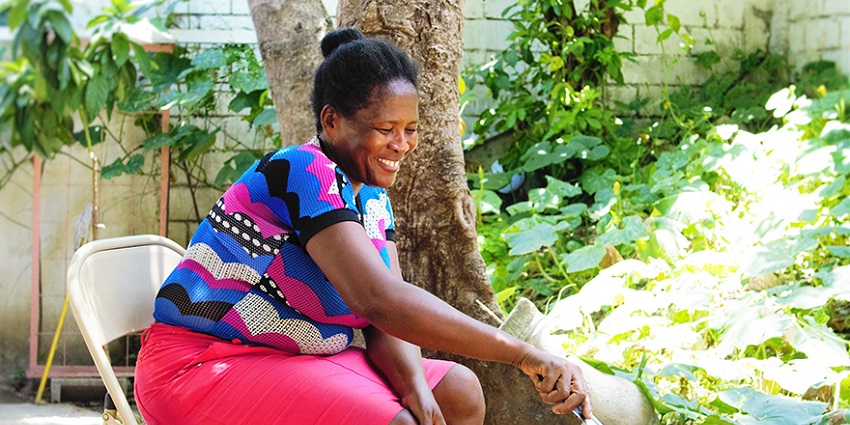
©Nicolas David
Access to clean energy is essential to meeting the needs of populations, particularly in rural and isolated areas. In Haiti, the social enterprise Palmis Enèji, in which the Foundation is a shareholder, provides a solution with ecological and economical cooking and lighting equipment. Coordinated by the NGO Entrepreneurs du Monde, the project continues to expand. It notably benefited from a Solidarity Bankers mission through the Foundation in anticipation of an upcoming fundraising round.
– Tell us about Palmis Enèji. How is it a social enterprise adapted to Haiti?
Jean-Farreau Guerrier, Coordinator: Palmis Enèji is a Haitian social enterprise specializing in the distribution and maintenance of clean cooking and lighting equipment for the most disadvantaged households in Haiti. In our country, the situation is critical and requires action. Already among the poorest on the planet, Haiti is experiencing a crisis that is severely affecting its population. Street protests are frequent, the security situation is deteriorating, and some areas are completely inaccessible. Affected by inflation of nearly 20%, households are losing purchasing power. 62% of them remain without access to electricity, and up to 85% in rural areas. As a result, families rely on candles or kerosene for lighting and charcoal for cooking. With its solar stoves and lamps, Palmis Enèji offers solutions to replace these rudimentary methods.
– What are the socio-economic impacts of your actions?
Through partnerships with microfinance institutions, Palmis Enèji offers financing solutions that facilitate the acquisition of equipment. Many households and professionals are thus converting to cooking with LPG gas, which is much less harmful than cooking with charcoal. The poorest families living in rural areas have almost no access to LPG, so they use our improved charcoal stoves, which consume 20% to 30% less than traditional stoves. Our solar lamps also provide them with light, a healthier and more comfortable lighting than candles. These solutions allow the poorest families to save money while reducing their ecological footprint: we estimate that we have contributed to saving more than 153,000 tons of forest wood and reducing harmful CO2 emissions by more than 203,000 tons. Finally, Palmis Enèji supports economic activity with a network of franchised microenterprises. The words of one of our resellers testify to the social utility: “I am proud to see the light shining in our families.”
– What future developments do you envisage?
We are pursuing the strong objective of making our health- and environmentally-friendly equipment accessible to everyone, in every village. To this end, we are prioritizing three projects: access to LPG through distribution centers in the center of the country and in the Grande-Anse department; the development of after-sales service; and the diversification of our product range.
___________________________________________________________
Source : 2019 Integrated Report, Grameen Crédit Agricole Foundation. Download here
[Interview] CA Val de France supports a Solidarity Bankers mission in Cambodia
Interview with Laurence Lebrun-Renoult, Managing Director, CA Val de France

©Philippe Lissac
Launched by the Grameen Crédit Agricole Foundation and Crédit Agricole SA, Solidarity Bankers is a skills-based volunteer program that offers Group employees technical assistance missions with organizations supported by the Foundation. In 2019, the Val de France Regional Bank supported a Solidarity Bankers mission in Cambodia. For 10 days in September, Dominique Rombczyk, Risk Analyst at the Regional Bank, went to Cambodia to carry out a "financial management" mission for the Cirque Phare (PPSE), a social enterprise in which the Foundation is a shareholder.
– What was your Fund’s motivation in participating in the Solidarity Bankers program?
When one of our employees took the initiative to apply for a Solidarity Banker mission, our Fund naturally supported his request and granted a week of skills sponsorship. Dominique Rombczyk was thus able to put his skills to use in the financial management of Cirque Phare (PPSE). PPSE is a Cambodian social enterprise that promotes social integration and youth empowerment through arts and culture. This is a source of pride for us because the approach is fully in line with our support values.
– What feedback do you get from this?
Solidarity Bankers is one of those programs that makes us more aware of the social consequences of our banking activities. It advances a sustainable vision of finance, both in practice and in spirit. Within our Regional Bank, the initiative led by our employee has made it possible to share and disseminate within the teams the human qualities of openness and commitment that we promote. In addition to communication at the Group level, his experience has, for example, made the headlines in internal communications. For us bankers, knowing how to mobilize our skills to serve others, opening up and adapting to a different context and to different issues are skills, "soft skills," that must inhabit our profession.
– What other actions does your Regional Fund take in terms of social inclusion?
As a regional bank, the issue of territorial social cohesion is a strategic priority. The CA Val de France Foundation leads initiatives in favor of local or regional associations working towards youth inclusion on the one hand, and intergenerational support on the other. We operate with them through skills sponsorship, on a voluntary basis, based on the same model as the Solidarity Bankers missions. For example, we are launching a project for youth training, for which all the expertise of our employees is welcome for support missions: assistance with financial management, animation, advice, etc. We also work with young people to support isolated people, often elderly people, which fosters dialogue between generations. All of this is part of a broader approach aimed at promoting the socio-economic autonomy of populations.
Source : Integrated Report 2019, Grameen Crédit Agricole Foundation. Download here
